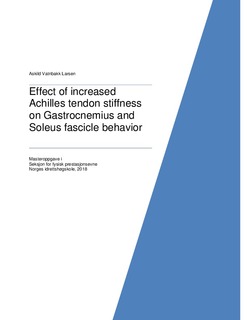Effect of increased Achilles tendon stiffness on Gastrocnemius and Soleus fascicle behavior
Master thesis
Permanent lenke
http://hdl.handle.net/11250/2504424Utgivelsesdato
2018Metadata
Vis full innførselSamlinger
Sammendrag
Introduction: The contribution of tendinous structures and contractile elements to movement is often studied separately, and their roles considered independently. However, tendons and skeletal muscles are integrated, and in functional movements, the mechanical properties of both affect how they work together to produce movement (Lichtwark & Wilson, 2007). The Achilles tendon (AT) and the gastrocnemius (GM) and soleus (SOL) muscles are integrated, and the AT reduces muscular work by contributing to the majority of length change of the muscle-tendon unit (MTU), storing and recovering elastic energy. The mechanical properties of the AT affect GM and SOL mechanical work, and thus tuning tendon stiffness could affect the behavior of GM and SOL muscle fascicles.
Purpose: The purpose of this study was to examine if an exercise induced increase in AT stiffness affect GM and SOL fascicle behavior by reduction of shortening amplitude and contraction velocity. It was aimed to increase tendon stiffness while minimizing adaptations of the muscles.
Methods: 11 healthy individuals (age 25.7 ±4.2 years) formed the training group, and trained explosive isometric one-legged calf raises three times a week for 10 weeks. 10 controls (age 29 ±3.7 years) did not change their training habits during this period. Measurements of mechanical properties of the AT and resting muscle architecture of the GM was performed as well as visualization of the GM and SOL muscles during running using ultrasonography. Kinematics and kinetics of the hip and right leg was also measured during running.
Beskrivelse
Masteroppgave - Norges idrettshøgskole, 2018
